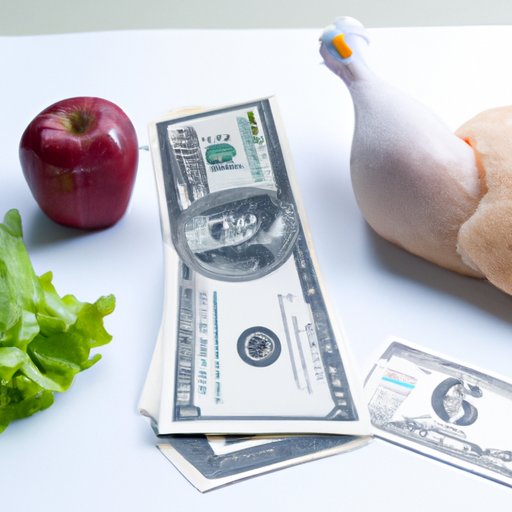Introduction
It’s no secret that healthy food can be more expensive than unhealthy food. But why is that? In this article, we’ll take a deep dive into the factors that contribute to the higher cost of healthy food, so you can better understand the economics of eating healthy.
Let’s start by defining “healthy food.” For the purpose of this article, we’ll define healthy food as food that is low in added sugars, saturated fat, and sodium; high in fiber; and made with whole grain and plant-based ingredients. Examples include fruits, vegetables, lean proteins, nuts, seeds, legumes, and whole grains.

Comparison of Cost of Unhealthy and Healthy Food Options
When it comes to the cost of unhealthy and healthy food options, there is a stark contrast. Generally speaking, unhealthy foods like processed snacks, sugary drinks, fast food, and frozen meals are much cheaper than healthier options like fresh produce, lean proteins, and whole grains. For example, a bag of potato chips may cost around $2.50, while a large container of blueberries may cost around $3.50.
So why is unhealthy food cheaper? There are several contributing factors, including the cost of production, government subsidies, and marketing expenses.

Benefits of Eating Healthy Food
Despite the higher cost of healthy food, it offers many benefits. Eating a diet of mostly healthy foods has been linked to a lower risk of chronic diseases such as heart disease, type 2 diabetes, and certain cancers. Eating healthy can also help you maintain a healthy weight, which can reduce your risk of developing health issues related to being overweight or obese.
In addition to the health benefits, eating healthy can also save you money in the long run. Although healthy food may cost more upfront, studies have shown that people who eat healthy tend to have lower healthcare costs over time. This is because they are less likely to develop chronic diseases, which can be costly to treat.
Impact of Government Subsidies on Food Prices
Government subsidies can have a big impact on food prices. The government provides subsidies to farmers and food producers to encourage them to produce certain types of crops and food products. These subsidies often benefit commodities like corn, soy, wheat, and dairy, which are used to create processed, packaged foods like chips, cookies, and soda.
Since these subsidized ingredients are much cheaper than their healthier counterparts, manufacturers can keep their prices low and still turn a profit. This makes unhealthy food much more affordable than healthy food.

Cost of Production for Healthy Food
The cost of production for healthy food is another factor that contributes to its higher price. Producing healthy food requires more resources, such as land, labor, and water, than producing unhealthy food. For example, organic farming typically involves more manual labor than conventional farming and is more expensive due to additional costs such as certification fees.
In addition, healthy food tends to have shorter shelf lives than unhealthy food. This means that producers must invest more money in packaging, storage, and transportation to get their products to market quickly and safely.
Ways to Make Healthy Food More Affordable
There are several strategies that can help make healthy food more affordable. One is to shop at farmers markets, which often offer locally grown produce for less than what you would pay at the grocery store. Another is to buy in bulk, as buying larger quantities of food usually costs less per unit.
Additionally, there are programs and initiatives designed to make healthy food more accessible. For example, the Supplemental Nutrition Assistance Program (SNAP) helps low-income households access healthy food, and some states have programs that provide free or discounted fruits and vegetables to those in need.
Cost of Marketing for Unhealthy Food
Marketing is another factor that contributes to the cost difference between unhealthy and healthy food. Unhealthy food companies often spend millions of dollars each year on advertising and promotion. This increases the visibility of their products, which can lead to more sales and higher profits.
On the other hand, healthy food companies tend to spend less on marketing. Because of this, their products may not be as widely available or well-known, which can lead to lower sales and higher prices.
Conclusion
We hope this article has helped you better understand why healthy food is more expensive than unhealthy food. There are many factors that contribute to the cost difference, including the cost of production, government subsidies, and marketing expenses. Despite the higher cost, eating healthy offers many benefits, including improved health and lower healthcare costs. There are also ways to make healthy food more affordable, such as shopping at farmers markets, buying in bulk, and taking advantage of programs that provide free or discounted fruits and vegetables.
If you want to eat healthy but are struggling with the cost, there are resources available to help. Reach out to your local government or health department to find out what programs and initiatives are available in your area.
(Note: Is this article not meeting your expectations? Do you have knowledge or insights to share? Unlock new opportunities and expand your reach by joining our authors team. Click Registration to join us and share your expertise with our readers.)
